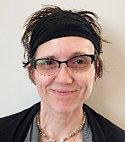
Stephanie Morrissette
Stephanie Morrissette is an avid naturalist and is a Library Assistant at the Reference and Local History Department at CDPL.
Do you love Halloween? For many, it is a favorite holiday. Halloween was first called Samhain (pronounced Sow-en) and was celebrated as the New Year for many earth-based religions. It was also called All Hallows’ Eve. Samhain was the night when the veil between this world and the other world was the thinnest, and spirits were thought to walk the darkness. Many hung talismans above the door to the home to ward off evil. These items were commonly a collection of sticks from certain trees or shrubs that were bundled and tied to the outside of the door or just above the door frame. Pumpkins were also carved and lit with candles to help keep the darkness at bay. Over the years, the phrase All Hallows Eve developed into Halloween. If you are interested in learning more about old ways in which Halloween was celebrated, check out this title in our Llewellyn collection: “Samhain: Rituals, Recipes, and Lore for Halloween” by Diana Rajchel (299.9 Raj).
If you find the book “Samhain” interesting, you can check out other books in the Llewellyn series, such as “Yule” by Susan Pesznecker (394.261 Pes v.7), which shares the history and rituals of the Winter Solstice, or “Imbolc: Rituals, Recipes, and Lore for Brigid’s Day” (299.94 Imb), which celebrates the beginning of spring. We also have “Ostara” by Kerri Conner (299.94 Con), which, continuing through the seasons of the year, shares the history and rituals of the Spring Equinox, when day and night are balanced. Beltane is another pagan sabbat, or tradition, and marks the third and last of the spring festivals. Beltane was once celebrated as the birth of plants and animals, and a time when handfasting, or marriages, were made. For in-depth information on this day, check out “Beltane” by Melanie Marquis (299.94 Mar).
Moving along through the seasons, we have Midsummer, another earth-based day, that marks the beginning of summer. Our book, “Midsummer: Rituals, Recipes and Lore for Litha” by Deborah Blake (299.94 Bla) is a good resource. Next is Lughnassadh, or the first of the harvest festivals, which falls on August 1st. Lughnassadh also means Lammas. There is information and ideas on celebrating in our book “Lughnassadh: Rituals, Recipes and Lore for Lammas” by Melanie Marquis that will prove educational (299.94 Mar). Next, we have the fall equinox, when light and dark are balanced again. This day is also known as Mabon, or the autumnal equinox, the second harvest festival. We have a book for that, too, and it’s called “Mabon: Rituals, Recipes and Lore for the Autumnal Equinox” by Diana Rajchel (299.94 Raj). This carries us through the year and bring us back full circle to Halloween.
Stay safe from those ghouls and ghosts, and happy Halloween! CDPL is open Monday-Thursday 9 am-9 pm; Fridays 9 am-5 pm, and Sundays 1-5 pm. If you have questions, you can always contact the Reference department at 765-362-2242, extension 117.
